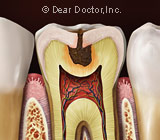 Did you know that the bacteria that cause tooth decay are usually transmitted to children from their parents, through sharing the same spoon or kissing? Once inside the child’s mouth, the bacteria live on the teeth in what is called a biofilm. When the child consumes sugary foods or drinks, the bacteria act upon the sugar to produce acids that eat away at the child’s teeth, producing tooth decay.
Did you know that the bacteria that cause tooth decay are usually transmitted to children from their parents, through sharing the same spoon or kissing? Once inside the child’s mouth, the bacteria live on the teeth in what is called a biofilm. When the child consumes sugary foods or drinks, the bacteria act upon the sugar to produce acids that eat away at the child’s teeth, producing tooth decay.
These bacteria thrive on carbohydrates such as bread, sweets, and sodas. Even fruit juices, which offer more vitamins than soda, are filled with sugars that lead to decay. The child’s saliva works hard to neutralize the acidity produced from these foods, but if the child often snacks between meals this neutralization process doesnât have a chance to occur.
The first sign of decay may be white spots on the teeth, an indication that minerals in the surface enamel have been dissolved in certain locations. Before it goes any farther, this process can be reversed by reducing the exposure to acids and using fluorides to strengthen the tooth surface.
Make sure your child sees a dentist by his first birthday, to provide preventive care and treat any beginning decay.
You can also help your child develop the habit of brushing his teeth with fluoridated toothpaste. It is important to use only a smear of toothpaste on the brush for very young children, and a pea-sized amount on the brush for children over the age of 2. Sometimes small children swallow their toothpaste, and excessive amounts of fluoride can cause staining on the teeth. When your children are very young, you must brush their teeth. As they get older, they can do it themselves, with your supervision. We can also apply fluoride varnish to strengthen the tooth surface and make it resistant to acids.
Brushing twice a day is a good start. But it can’t prevent tooth decay when a child is eating carbohydrates all day. One way to reduce the use of sugar is to use xylitol, a naturally occurring sweetener that looks and tastes like table sugar and improves oral health. Studies have shown that use of this sweetener reduces tooth decay in children.
Another good idea is to wean children from bottles and training cups as early as possible. Sometimes children are given bottles filled with milk or sugary beverages at bedtime to help them relax. A better idea for their teeth is to teach them to drink from a regular cup filled with milk — or preferably, with water.
Contact us today to schedule an appointment to discuss your questions about tooth decay in children. You can also learn more by reading the Dear Doctor magazine article “Managing Tooth Decay In Children With Chronic Diseases.” While this article focuses on children with health challenges, it contains excellent advice to help all children prevent tooth decay.



